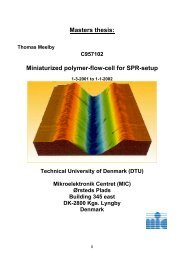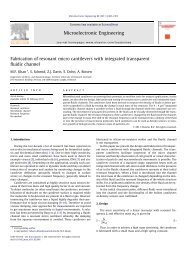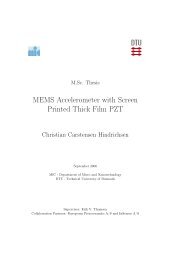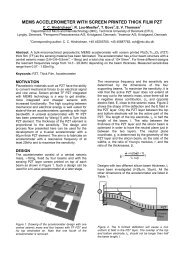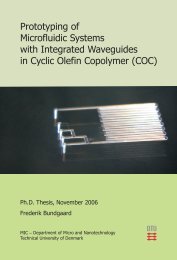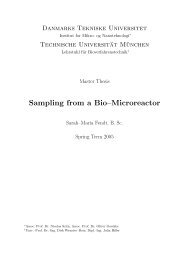Development of a Oxygen Sensor for Marine ... - DTU Nanotech
Development of a Oxygen Sensor for Marine ... - DTU Nanotech
Development of a Oxygen Sensor for Marine ... - DTU Nanotech
Create successful ePaper yourself
Turn your PDF publications into a flip-book with our unique Google optimized e-Paper software.
2.2. ISFET (ION SELECTIVE FIELD EFFECT TRANSISTOR) 9<br />
2. The optical fiber then carries the light to the probe. The end <strong>of</strong> the<br />
probe tip consists <strong>of</strong> a thin layer <strong>of</strong> a hydrophobic material, with ruthenium<br />
inside it, protected from the liquid measured on.<br />
3. The light from the LED excites the ruthenium at the probe tip.<br />
4. The excited ruthenium then fluoresces, emitting energy at 600 nm.<br />
5. If the excited ruthenium hits an oxygen molecule, the excess energy<br />
is transferred to the oxygen molecule in a non-radiative transfer, decreasing<br />
or quenching the fluorescence). The degree <strong>of</strong> quenching corresponds<br />
to the level <strong>of</strong> oxygen concentration or to oxygen partial pressure<br />
in the film, which is in dynamic equilibrium with oxygen in the liquid.<br />
6. The energy is collected by the probe and carried through the optical<br />
fiber to the data storage/PC. Which in turn translates the data into a<br />
graph or a similar output, from which the oxygen level can be read.<br />
Some <strong>of</strong> the advantages <strong>of</strong> the optodes is that unlike traditional electrodes<br />
the optodes doesn’t consume oxygen, and is there<strong>for</strong>e not sensitive to stirring.<br />
Also the partial pressure <strong>of</strong> the oxygen in the probe is in equilibrium<br />
with the partial pressure outside, there<strong>for</strong>e it is less effected by pressure and<br />
the pressure behavior becomes easier to predict. Finally some <strong>of</strong> the commercially<br />
available optodes comes with warranties with up to two years, which<br />
allows <strong>for</strong> long term measurements.[10]<br />
Disadvantages <strong>of</strong> the optodes however is that they tend to be relatively<br />
large (the optode itself is small, but the electronics and power supply adds<br />
considerably to the size), and is there<strong>for</strong> <strong>of</strong>ten attached to ships or buoys.<br />
It also have a relatively large power consumption in comparison to a micro<br />
Clark sensor.<br />
2.2 ISFET (Ion Selective Field Effect Transistor)<br />
Electrochemical sensors are one <strong>of</strong> the older and larger groups <strong>of</strong> chemical<br />
sensor, the sensor type includes those based on electrochemical and charge<br />
transfer reactions, meaning the transfer <strong>of</strong> charge from an electrode to a<br />
solid or liquid phase, or the other way around. The chemical process takes<br />
place at the electrodes or in the probed volume, and the current from this



